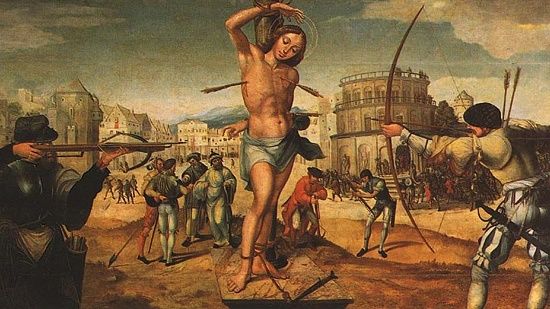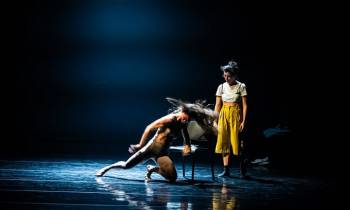Obras de referência da cultura portuguesa
"MARTÍRIO DE SÃO SEBASTIÃO"
de GREGÓRIO LOPES
Museu Nacional de Arte Antiga, Lisboa
Análise de Rui-Mário Gonçalves
Tradução: Alexandra Leitão

Concebida para a charola do Convento de Cristo, em Tomar, esta pintura de cerca de dois metros e meio de largura, num formato que ultrapassa o duplo quadrado, tende a ser olhada num movimento horizontal. Mas a disposição das figuras e as linhas de força da composição unificam a imagem. As três figuras do primeiro plano apresentam-se simetricamente: o Santo ocupa o eixo vertical e, de um lado e do outro, dois soldados apontam as flechas para o seu corpo. Subtilmente, as flechas sugerem uma linha mediana horizontal que, cruzando-se com o eixo vertical, divide a área da pintura em quatro partes. Cada uma destas partes enquadra o que se passa no segundo e terceiro planos. Os de baixo mostram no segundo plano agrupamentos humanos; os de cima, mostram no terceiro plano alguns edifícios, e deixam observar as cores claras do céu e das nuvens, em suas formas vagas, contrastantes com a cor castanha alaranjada do primeiro plano, representando minuciosamente a textura da terra.
Um dos encantos desta pintura advém destes jogos de cor luminosa, da economia da distribuição dos planos (apenas três) e da clareza da paginação, onde as figuras se recortam com grande nitidez. Entre estas figuras, a do Santo é dominante, não apenas pela sua posição central, mas também por ser a única que se individualiza, estando as outras reduzidas ao anonimato.
O autor desta pintura é Gregório Lopes que nasceu cerca de 1490 (?) e morreu em 1550. Teve aprendizagem na oficina de Jorge Afonso, com cuja filha Isabel casou, e cedo se interessou pelo Renascimento mais evoluído do Norte da Europa, já de caris Maneirista. Foi pintor régio de D. Manuel I e de D. João III.
Para o historiador Reynaldo dos Santos, encontra-se no quadro sobre S. Sebastião as características que identificam o autor. “O corpo hercúleo, numa visão das formas inspiradas no culto do Renascimento; o oval da face forte, enquanto sob as pálpebras se adivinham os olhos globosos; o desenho firme e um pouco duro, modelando pelo traço. Gregório Lopes mostra uma das facetas da sua personalidade no amor e fantasia com que trata os fundos, povoando-os de arquiteturas, por vezes de sabor regional, e na arte com que agrupa as multidões, com excelente desenho e arte de compor” (Reynaldo dos Santos, citado no Dicionário de Pintura Universal, Estúdio COR, pg. 207). Ao fundo deste quadro, vê-se, à esquerda edifícios nórdicos e, à direita, um edifício italianizante. A nitidez do desenho em todos os planos, mesmo os mais longínquos, como os dos edifícios citados, aliada ao cromatismo claro em redor da figura do Santo, confere a todo o quadro uma admirável capacidade de sugerir uma atmosfera límpida, suavemente luminosa, onde a transcendência da temática religiosa se revela em simultâneo com os apontamentos da vida terrestre.
"MARTÍRIO DE SÃO SEBASTIÃO" (1536-1539) by GREGÓRIO LOPES
Museu Nacional de Arte Antiga
This painting was conceived for the charola (rotunda or eight-sided chapel) at the Convent of Christ in Tomar. It is about 2.50 metres wide, slightly larger than a double square, and tends to be looked at in a horizontal movement. The disposition of the figures and the main lines of the composition unify the painting, however. The three figures in the foreground are presented symmetrically: the Saint on the vertical axis and on either side two soldiers pointing their arrows at his body. These arrows subtly suggest a horizontal median line that crosses the vertical axis and divides the painting into four parts. Each of these parts contains what is happening in the mid-foreground and in the background. The bottom parts show groupings of human figures; the top parts have buildings in the background whilst the clear colours of the sky and the shapeless clouds contrast with the orangey-brown of the foreground, representing the texture of the earth in detail.
What gives this painting some of its charm are the play of luminous colour, the economy of distribution of the planes (only three) and the clarity of the pagination from which the figures clearly stand out. Of these, the Saint’s figure is dominant, not only because of its central position but also because it is the only one that is individualised, all the others having been reduced to anonymity.
It was painted by Gregório Lopes, who was born circa 1490 and died in 1550. He served his apprenticeship in the workshop of Jorge Afonso, whose daughter Isabel he married. He took an early interest in the more developed Renaissance of the north of Europe, more Mannerist in style. He was the court painter of D. Manuel I and D. João III.
Reynaldo dos Santos, the historian, considers that the painting of Saint Sebastian contains the characteristics that identify the painter. “The Herculean body, in a vision of the forms inspired by the cult of the Renaissance; the oval shape of the strong face, the eyelids hinting at globular eyes; the firm, slightly rough drawing, shaping the outline. Gregório Lopes shows one facet of his personality in his loving and fantasy-filled fashion of treating the backgrounds, filling them with different architectural styles, some of which are regional, and the art with which he groups the crowds, excellently drawn and composed” (Reynaldo dos Santos, quoted in Dicionário de Pintura Universal, Estúdio COR, pg. 207). At the back on the left of the painting are Nordic buildings, whilst the right depicts a building in the Italian style. The clarity of the drawing in all the planes, even those furthest away, such as the buildings mentioned, combined with the clear colouring around the figure of the Saint, give this painting the admirable capacity of suggesting a limpid, softly luminous, atmosphere, where the transcendence of the religious theme is simultaneously revealed with the notes on an earthly existence.
Obras de Referência da Cultura Portuguesa
projeto desenvolvido pelo Centro Nacional de Cultura
com o apoio do Ministério da Cultura

 Divulgue aqui os seus eventos
Divulgue aqui os seus eventos















